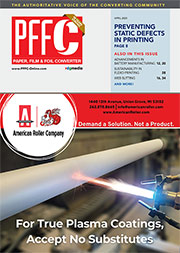Featured Stories
-
The Importance of Roll Cleaning and Maintenance
A question-and-answer with Joe Walczak, President of Sonic Solutions. -
Leveraging New Technology for Advancements in Battery Electrode Manufacturing
Machine designers and process engineers in the battery industry are witnessing a pivotal shift towards more space-efficient, precise and... -
Advantages of Shear, Razor and Crush Web Slitting Techniques
When choosing a slitting method, many factors must be considered, including interaction with inspection systems.
News | New Products
-
GMG Color Americas to showcase next-generation color management solutions at FTA FORUM & INFOFLEX 2025
GMG Color, a global leader in color management and proofing solutions, announces its participation in the FTA FORUM & INFOFLEX 2025
-
Kongsberg Precision Cutting Systems Launches IPC 3.1 For Faster, Smoother Table Operations
Kongsberg Precision Cutting Systems (PCS) has launched the latest version of its table operating software IPC 3.1.
-
EFI Showcases Latest Solutions Expanding the Possibilities of Digital Printing at the ISA International Sign Expo
Electronics For Imaging, Inc. (EFI™) is showcasing its newest hybrid and flatbed LED inkjet printers at the ISA International Sign Expo® in Las Vegas, April 23-25.
-
EMT International Expands Cutting Technology Portfolio with slittec Partnership
Strategic Alliance Enhances EMT's Comprehensive Slittling Solutions for Paper, Film and Packaging Industries
-
BW Converting Highlights Hudson-Sharp Pouch Machines at Petfood Forum 2025
Driving innovation in pet food packaging with high-performance bag and pouch converting machines
-
Mark Andy Sponsors 2025 Phoenix Challenge College Competition Advancing Workforce Development and Industry Engagement
Mark Andy, a global printing and labels solutions company, continues its support of the Phoenix Challenge
-
Cards & Systems Solutions Invests in Rollem InsigniaX3 to Expand In-House Die-Cutting Production
Cards & Systems Solutions, a leader in the manufacturing of plastic cards and comprehensive fulfillment services, has received a successful installation of the Rollem InsigniaX3 Rotary Die Cutter.
Expert Advice
New Printing Equipment: Who? How? What? When?
- Published: April 01, 2001, By Mark Piszczor, Research Analyst, Intertec Publishing
We asked converters about their plans for purchasing printing equipment. Here are the results.
Purchasing a new press or press equipment requires the involvement of several people, a considerable amount of time, and heavy expenditures. Paper, Film & Foil CONVERTER and Intertec Publishing conducted a research study to determine what converters are buying, what is important in the purchase, who is involved, etc.
A mail survey was sent on January 19 to 1,000 of PFFC's readers that indicated their business uses printing equipment and printing supplies. We received 222 usable surveys back, resulting in a 22% response rate. Of these usable surveys, 182 respondents reported involvement in the purchasing process.
Following is a summary of the survey results.
Two Factors Rate High
Respondents were asked to rate the importance of ten factors on a scale of 1-6, with 1 representing “extremely unimportant” and 6 representing “extremely important.”
Looking at responses of a 5 or 6, the two factors that scored the highest in terms of importance were “Product quality/reliability” (90% of involved respondents indicating importance); and “Parts availability” (85%).
Respondents indicated that money issues are the factors that are least important, with 24% rating “Lowest price” important and 14% rating “Financing availability” important.
Who Gets Involved?
When asked how many people in the converting organization will use these factors to make press equipment purchase decisions — in other words, how many people generally are involved in such decisions — 82% of survey respondents answered two to five people are generally involved. The average number of people involved is four.
| Factor | % | Mean |
|---|---|---|
| Product quality/reliability | 90 | 5.4 |
| Parts availability | 85 | 5.2 |
| Customer service | 72 | 5.0 |
| Technical support/training | 79 | 5.0 |
| Product features | 76 | 5.0 |
| Manufacturer reputation | 73 | 4.9 |
| Ease of installation/integration | 66 | 4.8 |
| Technological innovation | 65 | 4.7 |
| Lowest price | 24 | 3.7 |
| Financing availability | 14 | 3.1 |
| Base = involved respondents (182). | ||
The personnel of both the production/engineering and administrative/executive departments will almost always be involved in specifying the manufacturer or model of printing presses for purchase. Involvement of other departments is considerably lower.
On the other hand, the duty of approving the expenditure will almost always involve administrative/executive (95% of the time) and rarely involve production/engineering (25% of the time).
| Reason | % |
|---|---|
| An attempt to expand business | 66 |
| To meet the future needs of current customers | 61 |
| A replacement/upgrade was needed | 43 |
| To break into new product niches | 37 |
| The customer's specifications have changed | 17 |
| Other | 4 |
| Base = involved respondents with plans to purchase (117); multiple answer | |
The numbers look different again when asking which groups specify accessory parts/components/systems as part of a new press line. Now, production/engineering will specify almost every time, while administrative/executive will specify half of the time.
When given the choice on five separate press accessories, respondents indicated the converter typically makes the specification of brands/ models for three types of press accessories: drying/curing systems; surface treating systems; and web inspection systems. However, when it comes to tension controls and web guiding systems, the converter and press manufacturer jointly specify brands/ models for the press line.
From a list of eight different types of presses and systems, the flexographic press was the equipment most respondents indicated they plan to purchase during the next 12 months. Respondents chose either “Flexographic press” or “No planned purchase” by a large margin.
Of those indicating a press purchase over the next 12 months, 39.3% expect to run at widths less than 18 in.; 27.4% will run at widths greater than 36 in.; 13.7% at widths 18-24 in.; and 7.7% at 25-36 in. (12% gave no response as to width.)
How Much Are They Spending?
Spending on presses and related equipment for the year 2001 will not differ much from spending in 2000, according to the survey. The ‘across-the-board’ average dollar amount planned for spending in 2001 will near $655,000 for each converter.
It should be noted that nearly one-third of respondents answered that no press equipment spending is planned. After pulling this one-third out of the ‘across-the-board’ average dollar amount, the numbers show that spending will near $871,000 for each converter that does indeed plan to purchase in 2001.
| Type of Equipment | % |
|---|---|
| Flexographic press | 43 |
| Platemaking Sysytems | 13 |
| Digital press | 10 |
| CTP systems | 10 |
| Offset press | 9 |
| Digital proofing systems | 9 |
| Rotrogravure press | 7 |
| Letterpress | 3 |
| Other | 9 |
| None | 32 |
| Base = involved respondents (182); multiple answer | |
The anticipation of increased business is a major reason for new equipment purchases. The two dominating answers given as reasons for purchase included “An attempt to expand business” (66%) and “To meet the future needs of current customers” (61%).
Finally, what is the amount of time it takes to purchase new press equipment? According to the survey, from identifying the need to the actual equipment purchase, including the time it takes for all personnel and departments to give their input, the average amount of time is 8.5 months.













